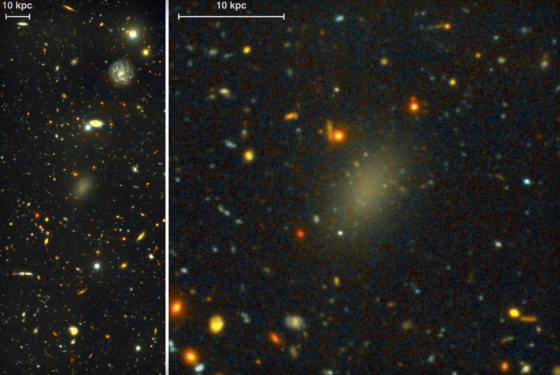Massive new Galaxy revealed to be 99% Dark Matter; Elder Things Everywhere
New galaxy. 99% Dark Matter. Let’s be honest, this is where the Elder Things are waiting. Waiting to reveal themselves. I, for one, love comma splices, and welcome them.
Powerful telescopes have revealed that a nearby galaxy is 99.99 percent dark matter. That number is a new record and the galaxy’s existence could help us learn more about the properties of dark matter, which makes up about 27 percent of the universe but hasn’t been officially detected.
The galaxy, called Dragonfly 44, is 300 million light years away. It has the same mass as our own Milky Way but has a hundred times fewer stars. The lack of stars means that the galaxy is dim enough to have been hidden for decades. It’s not the only galaxy to be composed of almost all dark matter, but most of the other ones are tiny dwarf galaxies, not ones a trillion times more massive than our Sun.
Astronomers at Hawaii’s WM Keck Observatory spotted Dragonfly 44 in 2014 as part of a group of galaxies in a region called the Coma Cluster. Scientists knew that there had to be something holding Dragonfly 44 together because it was impossible for it to stay intact just from the mass of its stars. Either the stars were bound together by dark matter, or the galaxy was unstable. Now we know.
In a study published today in Astrophysical Journal Letters, researchers used large telescopes to record the speed of stars in Dragonfly 44 for six nights. Speed is an important factor; the faster stars spin, the more mass the galaxy must have to keep the stars together.
The recorded speed of the stars — about 30 miles per second — suggests that there is a lot more mass in the galaxy than the stars themselves, according to lead author Pieter van Dokkum. “In the Dragonfly galaxy stars move very fast,” he told Wired. “So there was a huge discrepancy: using Keck Observatory, we found many times more mass indicated by the motions of the stars, than there is mass in the stars themselves.”
This finding suggests that all the rest is dark matter. And at 99.99 percent dark matter, Dragonfly 44 beats a galaxy in the Virgo cluster, which is merely 99.96 percent dark matter.




